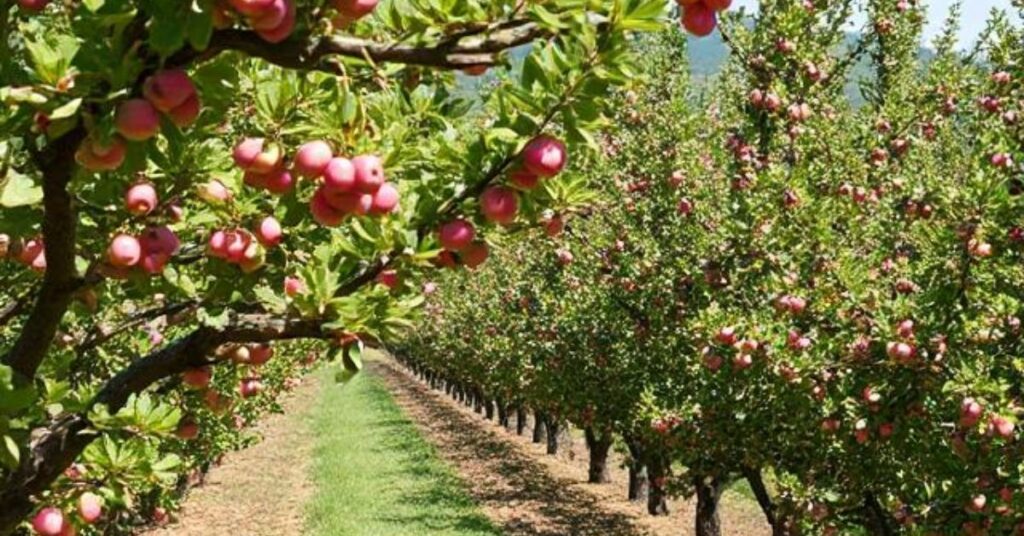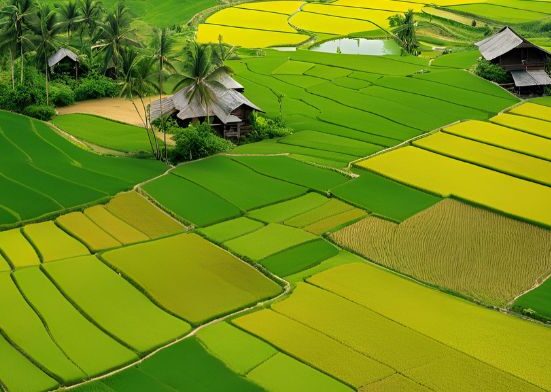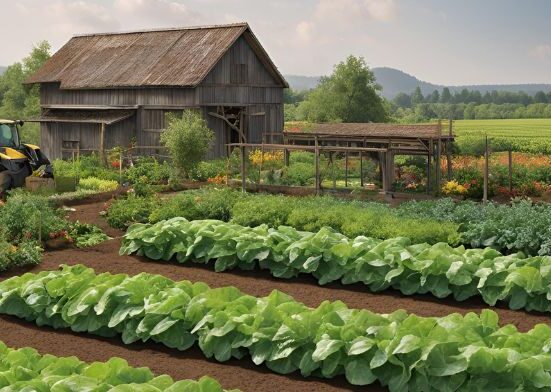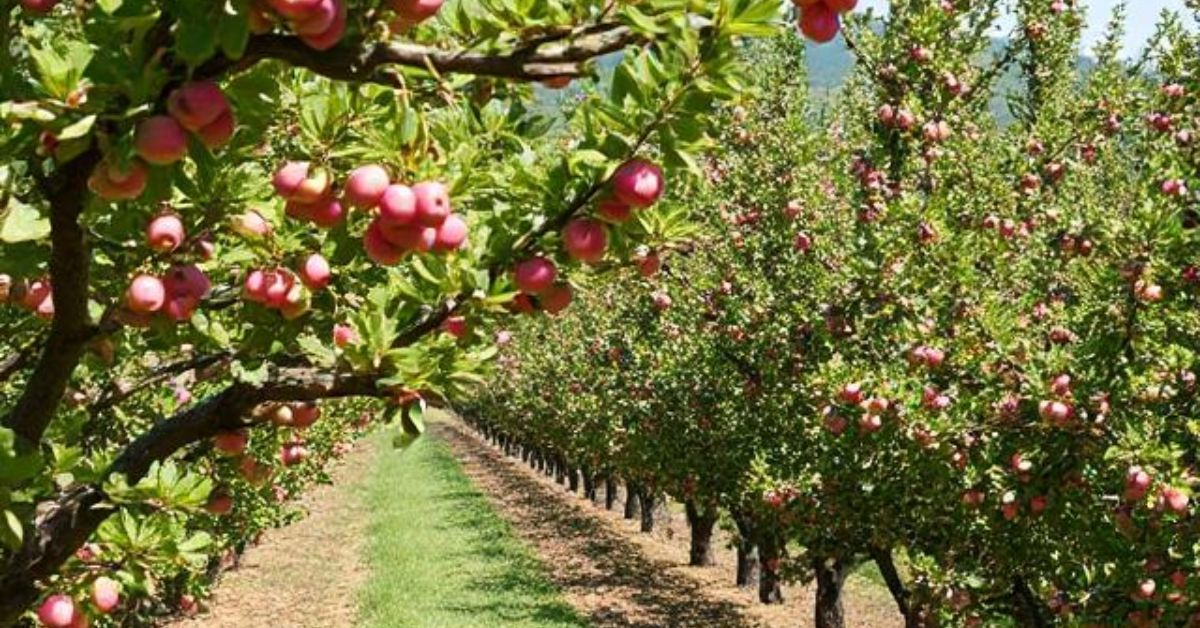Orchards are beautiful, organized spaces filled with rows of fruit or nut-bearing trees. These cultivated areas have been a part of human agriculture for centuries, providing fresh produce, shade, and scenic landscapes. Whether apples in a temperate valley or mangoes in a tropical region, orchards are crucial in feeding communities and supporting local economies. But what exactly is an orchard? How are they different from other types of farms or gardens? This blog post will explore what defines an orchard, its various types, and why they are crucial to our environment and food systems. Whether you’re a nature lover, define orchard, a gardening enthusiast, or simply curious, this guide will offer you a clear understanding of the world of orchards.
What Is an Orchard?
An orchard is a carefully planned area where trees or shrubs are grown to produce edible crops like fruits or nuts. Unlike wild forests or scattered backyard trees, orchards are intentional. Farmers plant specific varieties in neat rows, ensuring optimal sunlight, water, and space for growth. Apples, pears, peaches, cherries, almonds, and citrus are some of the stars of the orchard world, though the crops vary by region and climate.
Orchards aren’t just about food production. Ecosystems are teeming with life—pollinators like bees and butterflies thrive among the blossoms, while birds nest in the branches. Well-managed orchards also improve soil health, conserve water, Understanding Food Costs and Modern Farming Practices and sequester carbon, making them allies in the fight against climate change. But beyond their practical benefits, orchards carry a certain romance, evoking images of sun-dappled afternoons and baskets brimming with fresh fruit.
A Brief History of Orchards

The story of orchards stretches back thousands of years, intertwining with human civilization. Ancient Mesopotamia, often called the cradle of agriculture, saw early orchards of dates, figs, and pomegranates as far back as 3000 BCE. The Egyptians cultivated olives and grapes, while the Romans perfected techniques for grafting and pruning, spreading orchards across their empire. In medieval Europe, monasteries maintained orchards for food, cider, and medicinal herbs.
Orchard meaning took root in the Americas with European settlers. The 19th-century folk figure Johnny Appleseed came to represent this expansion, planting apple nurseries across the frontier. His apples weren’t for eating fresh but for hard cider, a staple drink at the time. By the 20th century, orchards had become big business, with regions like Washington’s Yakima Valley and California’s Central Valley emerging as fruit-growing powerhouses. Today, orchards are a global phenomenon, from Japan’s cherry groves to Spain’s olive orchards. Yet, despite their commercial scale, they retain a timeless charm, connecting us to our agricultural past.
Types of Orchards
Orchards can be classified in several ways, depending on the types of trees grown, the climate, and farming practices. Below are the main types of orchards:
Fruit Orchards
These are the most common types of orchards, dedicated to growing fruit-bearing trees. Examples include apple, mango, orange, peach, and cherry orchards. They are often cultivated for commercial fruit production and local consumption.
Nut Orchards
Nut orchards grow trees that produce edible nuts such as almonds, walnuts, pecans, and pistachios. These orchards require specific soil and climate conditions and are valuable for domestic use and export.
Mixed Orchards
Mixedorchardist meaning combine different types of fruit and nut trees in one area. This method promotes biodiversity, improves soil health, and lowers the possibility of complete crop failure caused by pests or illnesses.
Organic Orchards
Organic orchards avoid chemical pesticides and fertilizers and focus on natural farming methods. They follow strict organic certification standards and are gaining popularity for producing healthier, eco-friendly fruits and nuts.
Tropical and Temperate Orchards
Tropical orchard thrive in warm, humid climates and include trees like mango, banana, and papaya. Temperate orchards are found in cooler temperatures and typically grow apples, plums, pears, and cherries.
Each type of orchard serves a unique purpose and is shaped by environmental factors, farming goals, and market demand.
The Anatomy of an Orchard
Creating an orchard is both an art and a science. It begins with selecting the right site—ideally, a spot with well-drained soil, good sunlight, and protection from harsh winds. The climate and consumer demand influence crop selection. For example, temperate regions favor apples and pears, while subtropical zones excel in citrus and avocados. Farmers plant trees in rows, often spacing them 10 to 20 feet apart to ensure adequate airflow and light. Many orchards use dwarf or semi-dwarf trees, which are easier to harvest and produce fruit sooner than full-sized varieties. Irrigation systems, like drip lines, deliver water efficiently, Boosting Soil Health while cover crops between rows prevent erosion and enrich the soil.
Pruning is year-round, shaping trees to maximize fruit production and prevent disease. Pest management is another challenge—modern orchards often use integrated pest management (IPM), combining natural predators, traps, and minimal pesticides to keep bugs at bay. And let’s not forget pollination: many orchards rely on beehives to ensure a bountiful harvest.
The Seasons of an Orchard
One of the joys of an orchard is its ever-changing rhythm, tied to the seasons. Spring is a spectacle, with trees bursting into bloom. Pink and white blossoms transform the landscape, drawing pollinators and visitors alike. Farmers monitor the weather closely, as a late frost can damage delicate flowers and reduce the yield. Summer is a time of growth. Tiny fruits swell under the sun, and farmers thin the crop to ensure larger, healthier produce. Irrigation and pest control are critical, especially in hot, dry climates. Early varieties like peaches and plums are ready for harvest by late summer, kicking off the busy season.
Fall is the orchard’s grand finale. Apples, pears, and nuts ripen, and the air fills with the scent of fresh fruit. Harvesting is labor-intensive, what is orchard farming, often done by hand to avoid bruising. Many orchards open to the public during this time, offering pick-your-own experiences that draw families and tourists. Winter, though quieter, is far from idle. Farmers prune trees, repair equipment, and plan for the next season. Bare branches against a gray sky might look dormant, 5 Common Mistakes In Sprinkler System Design but beneath the surface, the orchard rests, ready to spring to life again.
Orchards and Sustainability

Orchards are examples of sustainable agriculture in an era of climate change and food insecurity. Trees are long-lived, often producing for decades, unlike annual crops that require yearly replanting. Their deep roots stabilize soil, prevent erosion, and store carbon. Orchards also support biodiversity, providing habitats for wildlife and pollinators.Many modern orchards embrace eco-friendly practices. Organic orchards avoid synthetic pesticides, relying on natural methods like companion planting and beneficial insects. Agroforestry, the practice of combining trees with crops or animals, is gaining traction, creating resilient, diverse systems. Even water use is becoming more efficient, with technologies like soil moisture sensors and rainwater harvesting.
orchard def also play a social role. Often found in urban areas, community orchards provide fresh produce to underserved neighborhoods, promote food justice, and foster a sense of connection. These spaces remind us that orchards aren’t just about profit but people and the planet.
The Cultural Significance of Orchards
Orchards have woven themselves into the fabric of human culture. In literature, they symbolize abundance and renewal—think of the Garden of Eden or the cherry orchard in Chekhov’s play. In art, painters like Vincent van Gogh captured the beauty of blossoming trees, their vibrant colors evoking hope and vitality.Orchards inspire festivals and traditions worldwide. Japan’s cherry blossom festivals, while not strictly about fruit orchards, celebrate the fleeting beauty of tree blooms.
In England, wassailing—a ritual to bless apple trees for a good harvest—dates back centuries. In the U.S., apple-picking season is a cultural institution, with families flocking to orchards for hayrides, cider, and pumpkin patches. Modern Commercial Agriculture Orchards also hold spiritual significance. In many cultures, fruit trees represent life, fertility, and wisdom. Planting an orchard can be an act of faith in the future, a legacy that outlives the planter.
Benefits of Orchards
Orchards offer many benefits beyond just producing delicious fruits and nuts. They contribute to the environment, support the economy, and promote healthier lifestyles. Here are some of the key advantages:
Environmental Benefits
Orchards are vital in improving air quality by absorbing carbon dioxide and releasing oxygen. They also help reduce soil erosion, improve water retention, and support biodiversity by providing habitats for birds, bees, and pollinators.
Economic Benefits
Fruit and nut production generates farmer income and creates job opportunities in rural areas. Many regions depend on orchards as a significant source of agricultural revenue, both for local markets and export.
Health and Nutrition
orchid pronunciation provide fresh, seasonal produce rich in essential nutrients, vitamins, and antioxidants. Eating fruits and nuts directly from the source lessens dependency on manufactured foods and promotes better eating practices.
Aesthetic and Recreational Value
Well-maintained orchards enhance the beauty of landscapes and can serve as tourist attractions. Many enjoy visiting orchards for fruit picking, photography, and nature walks.
Educational Opportunities
Orchards offer a hands-on way to learn about agriculture, sustainability, and the life cycle of plants. Schools and communities often use them for educational programs and environmental awareness.
Challenges Facing Orchards
Despite their resilience, orchards face significant challenges. Climate change is a major threat—unpredictable weather, from droughts to early frosts, can devastate crops. In 2024, for example, extreme heat in California reduced yields for some almond orchards, while hurricanes damaged citrus groves in Florida.Labor shortages are another hurdle. Harvesting fruit is labor-intensive, and many orchards rely on seasonal workers, whose availability has dwindled due to immigration policies and economic shifts. Like robotic harvesters, automation is emerging but remains expensive and impractical for small farms.
Pests and diseases also loom large. Fire blight, a bacterial disease, can wipe out apple and pear trees, while invasive species like spotted lanternflies threaten orchards in the U.S. Northeast. Farmers must stay vigilant, balancing ecological concerns with protecting their livelihood.Finally, market pressures can squeeze small orchards. Large-scale agribusiness often dominates, driving down prices and making it hard for family farms to compete. Many small orchards survive by diversifying—offering agritourism, value-added products like jams, or direct-to-consumer sales.
The Future of Orchards

Despite these challenges, the future of orchards is bright. Technology is transforming the industry, from drones that monitor tree health to AI-driven yield predictions. Genetic research produces hardier, disease-resistant tree varieties, while urban orchards bring fruit production into cities. Consumer trends also favor orchards. Demand for organic, locally grown produce is soaring, and people are eager to reconnect with their food sources. Orchards that offer experiences—like farm tours, orchard definition, cider tastings, or yoga among the trees—are tapping into this desire for authenticity.
Globally, Orchard are being recognized as tools for climate resilience. In regions like Sub-Saharan Africa, fruit tree planting is combating desertification and improving food security. Initiatives like the Great Green Wall aim to restore landscapes with millions of trees, including fruit-bearing ones.
Why Orchards Matter
Orchards are more than just places to grow fruit—they symbolize hope, hard work, and harmony with nature. They remind us of the beauty of patience, as trees take years to bear fruit but reward us with decades of bounty. They connect us to our ancestors, who tended similar groves, and future generations, who will inherit the earth we steward.
Whether biting into a crisp apple, sipping cider by a fire, or strolling through a blooming orchard, you’re partaking in a tradition as old as civilization. So, The Complete Beginner’s Guide to Drip Irrigation next time you pass an orchard, take a moment to appreciate its quiet magic. Better yet, visit one—pick a peach, plant a seed, or bask in the shade of a tree. You’ll be glad you did.
FAQ
What is an Orchard Farm?
An orchard is a plot of land used to produce fruit or nut trees. Systematically. It is carefully managed for commercial fruit production or personal use and often features trees like apples, mangoes, almonds, or oranges.
What Trees Are Commonly Found in Orchards?
Common orchard trees include apple, mango, orange, cherry, almond, walnut, and peach trees. The type of tree depends on the region’s climate, soil, and purpose—whether for fruit, nuts, or a mix of both.
How are Orchards Maintained?
Orchards require regular care, including pruning, irrigation, fertilization, pest control, and harvesting. Proper spacing and maintenance improve tree health, increase yield, and ensure high-quality produce throughout the growing season.
What are the Benefits of Having an Orchard?
Orchards provide fresh produce, support biodiversity, reduce carbon dioxide, and contribute to the local economy. They also offer educational and recreational value, making them environmentally and socially beneficial.
Can I Grow a Small Orchard at Home?
With enough space and the right climate, a small orchard can be grown at home. Choose suitable trees, plant them with proper spacing, and follow basic care practices for healthy growth and fruit production.







